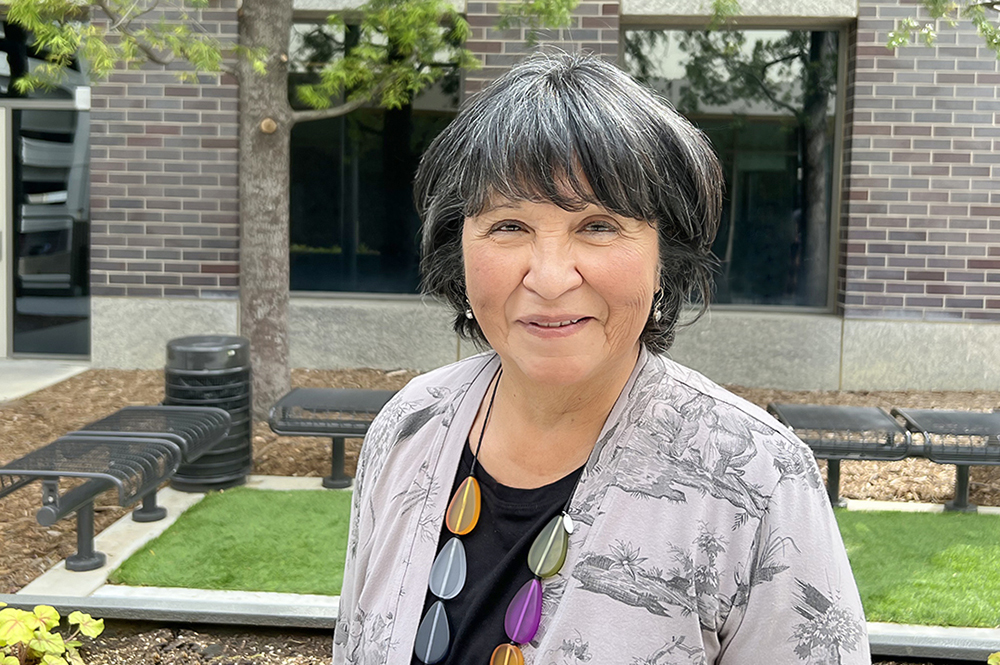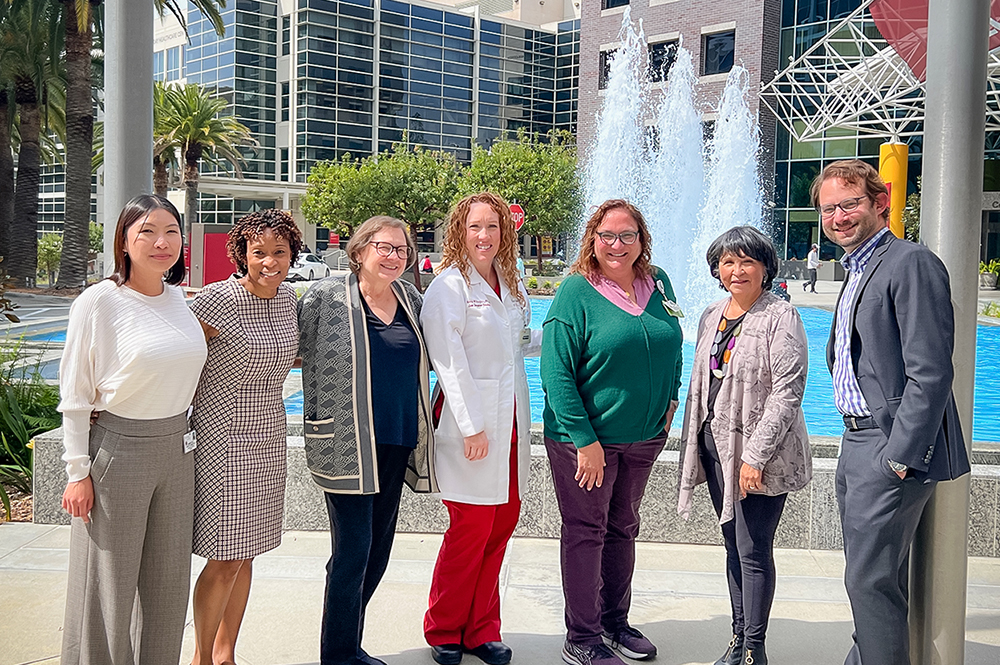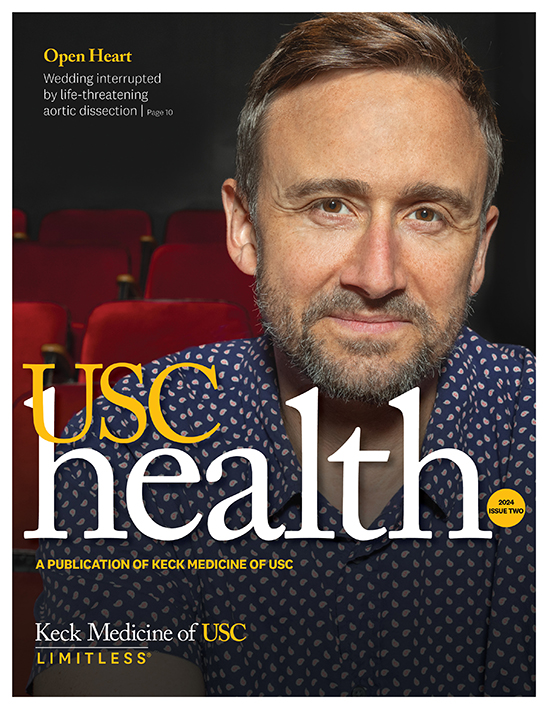
Benigna Carrillo received the first liver transplant performed by USC doctors. On her transplant’s 27th anniversary, she reflects on her journey.
When Benigna Carrillo left a medical appointment recently, she was surprised to find her transplant care team gathered in the reception area.
The group had gathered to remember — and celebrate — the 27th anniversary of Benigna’s liver transplant surgery.
It was the first to be performed by USC doctors, a milestone that “gave birth to the liver transplant program in our health system,” says Samantha Ramirez, FNP-BC, clinical supervisor of Keck Medicine of USC’s Liver Transplant Program.
Nearly four decades ago, the Pasadena resident began to experience debilitating fatigue and intense itching all over her body.
Her doctor’s diagnosis: cirrhosis resulting primary biliary cholangitis (PBC), a rare disease in which the liver’s bile ducts become inflamed and are eventually destroyed. The condition can also lead to liver scarring and failure.
As her symptoms worsened, Benigna was referred to Rick Selby, MD, who worked at a USC university hospital that would eventually become part of Keck Medicine.
USC Liver Transplantation Program — then vs. now
At the time, Dr. Selby was early in his career as a surgeon.
In the years since, he served a lengthy stint as the director of the Liver Transplantation Program and chief of the division of abdominal transplantation and hepatobiliary and pancreatic surgery.
Jeffrey Kahn, MD, now serves as the program’s medical director — with Aaron Ahearn, MD, as co-surgical director — and Dr. Selby works as a hepatobiliary and pancreatic surgeon at Keck Medicine.
The procedure itself hasn’t changed much since the 1990s. “You take out the old liver, hook up a few blood vessels and a bile duct, and you’re done,” Dr. Selby says.
However, advances in pre- and post-transplant treatments — such as immunosuppressants to help the body accept the organ — have made things much easier on patients in recovery.
“Now, we can customize our treatment approach according to the patient’s individual needs,” Dr. Selby says. “Also, the increased availability of livers thanks to living donors has been a great help to patients.”
Dr. Ahearn agrees, adding that living donors are helping to make a difference in a long-standing impediment to care.
We were able to give not only Benigna a second chance, but also her children and grandchildren, along with others who love her. That’s really why we do what we do.
Tammy Harper, NP-C, nurse practitioner, Keck Medical Center of USC
“Before, patients could wait years for a liver from a deceased donor,” Dr. Ahearn says. “But things have greatly improved since the 1990s. However, demand is still outpacing supply so many patients still die or become too weak for surgery before getting a match.
“That’s why we continue to innovate to get more people transplanted, especially with the utilization of living liver donation.”
Because the liver is the only organ in the body that regenerates, people can donate up to 50% of theirs while still alive.
Still, in 2022, only 6.4% of the 2443 liver transplants performed in the U.S. came from living donors, according to metrics from the United Network for Organ Sharing that works with the federal government.
Not only do organs from living donors increase the number available in the national registry, they also deliver benefits that include immediate organ function, greater longevity and reduced rejection risk.
“We encourage everyone to register for living donation,” Dr. Ahearn says, “especially people of racial and ethnic minorities to help solve the shortage of matching organs for these populations.”
Preparation for groundbreaking liver transplant surgery
Due to the liver shortage, Benigna had to wait to meet a certain acuity standard before becoming eligible for the wait list.
By 1995, her skin was gray, and she was so fatigued she could barely get out of bed. In November, Dr. Selby was able to add her to the wait list.
Since this would be the first liver transplant performed by USC-affiliated doctors, Medicare and Medi-Cal — along with other providers — had stipulations requiring extensive experience at the liver transplant center prior to agreeing to reimbursement for the surgery.
To offset the cost, Benigna’s care team threw a fundraiser: a night of salsa dancing.
“A lot of people came, danced and contributed, and on the strength of that we were able to say to the university hospital, ‘Here’s our down payment on the transplant program.’” Dr. Selby says.
On May 23, 1996, Benigna was called in to receive her new liver. Thoughts of her four children — Francisco, Elizabeth, Mia and Michael — bolstered her courage.
“As I walked down the porch steps I thought, ‘I may not see these steps again,’” Benigna says. “But I put that out of my mind because I had to be positive for the sake of my children. I had to come back.”
Dr. Selby told his patient that she would immediately get her color back if the surgery was a success.
When Benigna woke, her complexion was back to normal.

Ideal outlook following liver transplant
An avid world traveler, Benigna was able to visit Europe soon after her transplant. Today, at 74, she enjoys excellent health.
“The care I’ve received at Keck Medicine has been wonderful — from Dr. Selby up to the people who take care of me today,” says Benigna, who attends annual follow-up visits. “They’re brilliant at what they do, and so kind. They’re always checking up on me.”
At her anniversary celebration, Benigna’s care team voiced their admiration in return.
“She’s an ideal patient and extremely involved in her care,” says Tammy Harper, NP-C, who cares for her today. “I often tell her, ‘Ms. Carrillo, you’re going to outlast us all!’”
Harper added that Benigna’s journey encourages her.
“We were able to give not only Benigna a second chance, but also her children and grandchildren, along with others who love her,” Harper says. “That’s really why we do what we do.”
Dr. Selby, who is now good friends with Benigna, agrees that she is an inspiration.
“You see a patient like Benigna, who had been sick for about 20 years, now as well as they were the day they were born,” he says. “It’s why everyone goes into medicine: to see if you can reverse their illness — and it’s true in transplants.”
Topics


